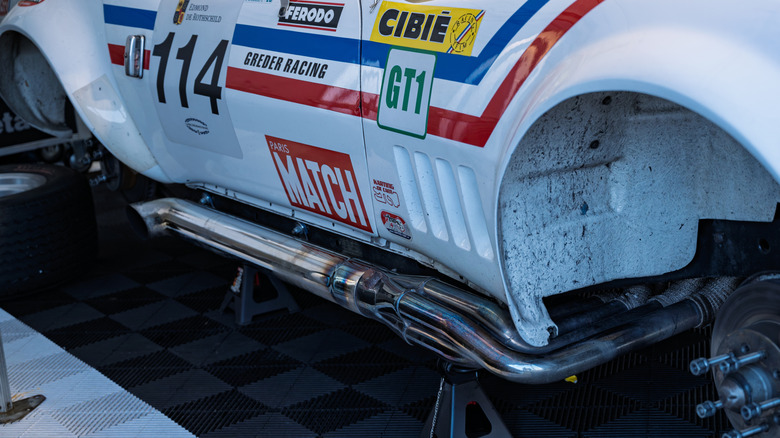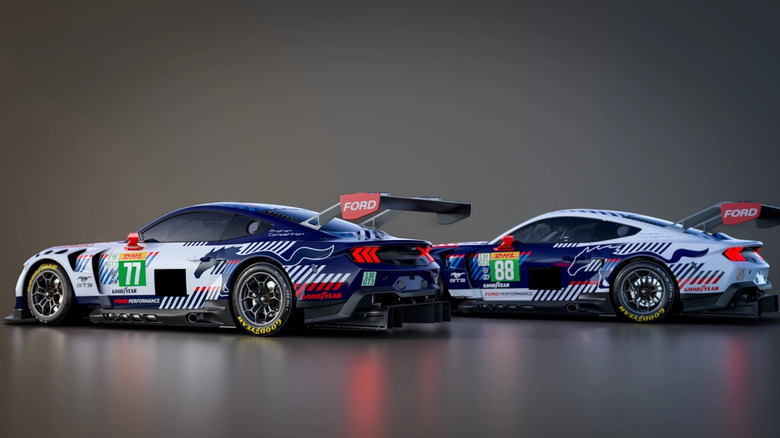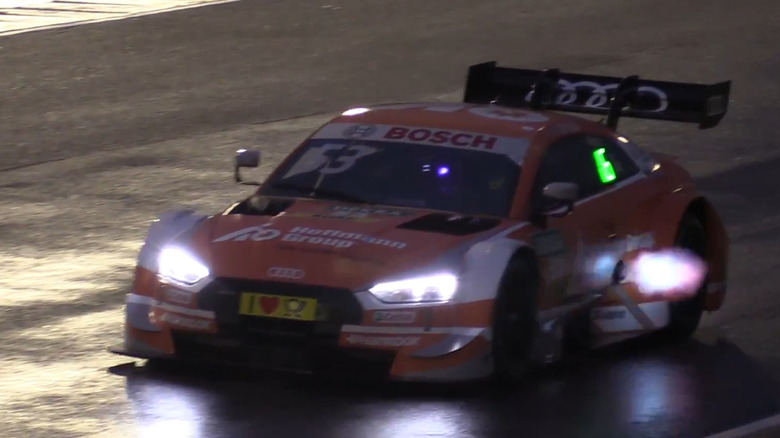Why Some Race Cars Have Their Exhausts Mounted On The Side
If there's one thing most race car bodies have in common, it's a preference for function over form. While many may resemble regular road cars, underneath that exterior lies a host of bespoke equipment dedicated to one singular purpose: Making the car go as fast as possible, as reliably as possible, within the rules of whatever discipline it's running in. This means that most race cars you'll see feature prominent components normally not seen on standard road cars, such as large aerodynamic devices, roll cages, lowered suspension, and grippy tires. Among the most distinctive of these elements — so distinctive, in fact, that their presence is essentially synonymous with race cars, is the side-exit exhaust pipe.
The most obvious reason anyone fits a side-exit exhaust to their car is, frankly, because it looks cool. But that's beside the point; these actually serve a functional purpose on racing machines, and that has to do with the car's undercarriage. Every vehicle has a set amount of clearance between it and the road, and most race cars try to minimize that as much as possible to help lower the center of gravity. The manipulation of air underneath a car is crucial to how these vehicles generate grip, so much so that the fastest vehicles use specialized curved plates and rear diffusers to shape the airflow and create pressure zones to actively "suck" the car down. In a front-engined car, running exhaust pipes all the way out the back means you now have to lift the car up and potentially disrupt some aerodynamic elements, among other factors like ease of maintenance. Let's discuss these in greater detail.
The aerodynamic benefits of side-exit exhaust
While it goes without saying, a car's exhaust is a physical object which occupies space, and that space is a premium in racing machines where every microsecond of speed counts. Unless you want to provide a portable heater for the driver, it's generally ill-advised to place the red-hot exhaust in the cabin, which means it must rest below the car. That's not a problem in most cars, whereby the exhaust pipe works its way around the vehicle's exposed undercarriage geometry like suspension and framework before exiting out the back. However, that's not necessarily an option in race cars, which have more specialized underbodies.
To demonstrate this, consider the Ford Mustang GT3 and its $300,000 roadgoing GTD counterpart, both of which feature side-exit exhaust. These pipes run on the outside of the chassis between the front and rear wheels, as opposed to down the middle in many cars, because the Mustang GT3 prioritizes this space for aerodynamically-shaped underbody plates. These plates help redirect air and cool various vital components within the car, as well as manipulate air pressure in specific ways.
A similar and more extreme example is the 2015 Nissan GT-R LM NISMO, a car with exhaust pipes emanating from the hood. This allows for two massive tunnels to run nearly unimpeded down the length of the car, acting as an aerodynamic and cooling aid. In other words, the idea is to make use of as much of the airflow as possible, and air underneath the car is just more free real estate to be exploited; traditional rear-exit exhaust on front-engined vehicles would interfere with that.
Other pros and cons
Aside from the aerodynamics behind it, there are some other tangible benefits to running side-exit exhaust: namely, maintenance, weight, and size. The latter two are obvious enough; less metal takes up less room and weighs less. Maintenance-wise, however, it's more nuanced. Many modern race cars feature modular crash structures designed to be dismantled quickly to fix any issues that crop up, a tool that proves especially useful in long-distance endurance races. Let's say there's an issue with the rear suspension, or it requires adjustment; it's far easier to perform such a task when there's not a scalding-hot pipe inches away from the working surface.
Moreover, it's less that can get damaged in the case of scraping. Race cars are generally low to the ground, sometimes even bottoming-out and showering the track with sparks. This produces wear on the various materials under the car. Instead, a side-exit exhaust allows the pipe to be out of harm's way, where it's less prone to damage and will never bottom-out.
Lastly, there's the reasons of weight and space-saving. Having an exhaust pipe running the length of the car requires additional engineering that's not strictly necessary on a racing machine. This directly opposes side-exit exhaust on road cars, which exist in small numbers but face certain quirks. For example, the first-gen Dodge Viper earned a reputation for burning occupants' calves when exiting with hot pipes, among lacking other basic conveniences. Moreover, it's difficult to fit sound-deadening mufflers and catalytic converters to side-exit exhaust. Therefore, with underbody aero and pit lane adjustments a non-issue for most cars, you'll hardly ever see roadgoing variants with these pipes outside of street rods and specific sports cars like a C2 Corvette.


